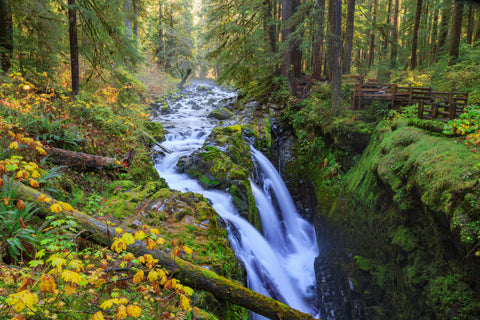Where is Olympic National Park
Olympic National Park is one of the most visited and diverse parks in America. It’s located in the Pacific Northwest on the Olympic Peninsula in Washington state. Directly south lies the Olympic National Forest. Three borders of the park are significant bodies of water; the Hood Canal, Salish Sea, and Pacific Ocean. Olympic National Park is an hour and a half from Tacoma, and just over two hours from Seattle. British Columbia lies just across the sea, only 2 hours away by ferry to Victoria.
How Big is Olympic National Park
Olympic is one of the biggest and robust US National Parks. It covers roughly 1,442 square miles. The park contains four regions: alpine, forest, rainforest, and Pacific coastline. There are also three separate ecosystems in Olympic National Park: coastline, temperate rainforest, and glaciated mountains. There’s 60 miles of coastline in the park. The Hoh and Quinault Rainforests get about 150 inches of rain each year. The center of the park features monstrous mountains, like Mount Deception rising to a dizzying elevation of 7,788 feet.

Olympic National Park Weather
Summer is the most popular time for visitors with good reason. Olympic is mild and warm, with the occasional thunderstorm. Though it is sunny, fog continues to roll through the coastal strip. In fall, the temperature drops, and precipitation increases. Snow can appear as early as September in the mountains. As the higher elevations begin to freeze, parts of the park start closing. Rain and snow are frequent in the winter. Hurricane Ridge on average gets around 30-35 feet of snow. It’s a popular place for skiing. Be sure to check for avalanche conditions before going out skiing or snowshoeing. As spring approaches, the weather warms up. Heavy rain or snow is possible in the mountains as late as June. Campgrounds open back up and the animal populations come to life.
When did Olympic become a National Park
President Grover Cleveland gave the area its first national designation in 1897 as Olympic Forest Reserve. President Teddy Roosevelt went a step further and made part of the reserve Mount Olympus National Monument in order to protect the threatened Roosevelt Elk. In 1937, President Franklin Roosevelt visited Olympic and a year later signed the act to designate Olympic National Park.

Things to do in Olympic National Park
There are tons to see and do at Olympic National Park all year long. Our National Parks Guide outlined some of the most popular attractions below so you can start planning your trip now!
Mount Olympus
Towering above the Olympic peninsula and Pacific coastline at 7,980 feet is Mount Olympus. It’s the tallest mountain in Washington and the centerpiece of the park. There are hiking trails around the base of the mountain. You can climb Mount Olympus with a permit.

Ruby Beach
Ruby Beach is secluded and serene. The red-tinged beach is long with lots of driftwood. There are numerous sea stacks bursting from the water just off the beach. Destruction Island and its lighthouse are visible. The area features many popular hiking trails and camping opportunities.
Hoh Rain Forest
Hoh Rain Forest is one of the largest temperate rainforests in the country. Hike trails through the trees and along the Hoh River. Catch a glimpse of rare birds, otters, bears and other extraordinary wildlife. Start your journey at the Hoh Rain Forest Visitor Center.
Lake Crescent
This area is one of the most popular parts of the park. Lake Crescent is deep but crystal clear due to no algae growth. This mountain lake offers plenty of camping and hiking opportunities. Lake Crescent is also a paddle boating and fishing hot spot.
Hurricane Ridge
If you’re looking for a snowy and rugged adventure, head out to Hurricane Ridge. It’s the most popular spot in the park for skiing and snowboarding. There are excellent hiking trails too. Hurricane Ridge offers stunning views of the rolling meadow below and Mount Olympus.

Marymere Fall
There’s hundreds of falls in Olympic, but Marymere Falls is gorgeous and easy to access. Water rushes from a height of 90 feet, fed from Falls Creek descending Aurora Ridge. Hike to the falls through an old growth forest on a peaceful one mile path.
Animals in Olympic
Between the different zones and ecosystems, Olympic National Park has a very diverse selection of wildlife. The ocean features marine life like urchins and sea stars, fish, seals, otters and whales. The forests feature elk, bear, salamanders and frogs. There’s hundreds of species of birds.
Tide pooling
Tidepooling is one of the most popular activities unique to the park. Kalaloch's Beach 4 and Mora's Hole in the Wall are excellent spots to try. Spy creatures like sea stars, anemone, eels, and many more for a short time while the tide is low.
Kalaloch Campground
There are several amazing campgrounds around the park. One of the prettiest is beachside Kalaloch Campground. Camp with expansive views of the Pacific Ocean on a bluff with access to many trails. If you’re visiting in the summer, make sure you make a reservation early.
Hiking Trails
There are more than 600 miles of trails in Olympic, ranging from easy to very challenging. Hike through lush meadows and mature rainforests. Walk along the river, lakes or the coastline. Climb over rugged peaks and top mountains. No matter what you choose, you’re sure to have a stellar view!

When to go to Olympic National Park
Olympic National Park is open year-round. You can visit anytime, it just depends on what you want to do when you get there. The most popular time for guests is July through August. The weather is the calmest and warmest of the year. The park is fully open; the crowds are thick. May through June is the next most popular time to visit. The weather is still warm though rainy. Most of the park is open and there is plenty of wildlife activity. If you’re looking for serenity and solitude, September and October are good times to visit. It’s chilly and can be snowy. Parts of the park have closed, but the crowds are gone. If snow is your favorite, visit from November through April.
Must-Haves to bring to Olympic
When you’re going to be spending time out in nature there are some supplies you’ll want to bring along. List of Parks made a list of the most important items down below.
Rain Jacket
Olympic National Park is wet and rainy. Showers pop up at a moment's notice. You’ll need to keep dry to avoid hypothermia. You’ll want to bring a sturdy, waterproof rain jacket. One that is lightweight and easy to stick in a day pack works best.
Sunglasses, Sunscreen and a Hat
You’re going to be out in the sun having fun. Protect yourself from getting sunburn by wearing sunscreen. Be sure to use at least 30 SPF or higher. You’ll also want to bring UVA/UVB-blocking sunglasses and a hat. Wide-brimmed hats offer the most protection.
Lots of Layers
Olympic National Park has multiple ecosystems with their own weather and climate. You’ll want several layers that can take you from the rocky coastline, through the lush rainforests and up the chilly mountains. Temperatures can vary between zones by up to 20 degrees.
Hiking Boots
If you want to summit the mountains of Olympic, like Beehive or Cadillac mountain, you need to bring along a good pair of hiking boots. They should be sturdy and lightweight. Don’t bring new boots - they need to be broken in to avoid blisters.

Water Shoes
The tidal pools and coastline of Olympic National Park is rugged and rocky. Hard-soled water shoes are highly recommended if you plan on getting in. The tidal pools have sharp barnacles and jagged rocks. The rocks are also slippery, so test the rocks before stepping!
Cellphone Tour Number
The park offers an interesting and insightful audio tour. The tour highlights nine different areas of Olympic. To access the tour just call 360-406-5056. If you have a smartphone you can access the tour online, which features 100 more info points and an interactive map.
Binoculars
There’s a lot to see at the park! See even more by bringing a pair of binoculars. Catch a glimpse of cresting dolphins or migrating whales off the coast. Spot Bald eagles soaring high above. Spy Roosevelt elk and black bears from a safe distance.
Water and Snacks
Though you’ve got plenty of options for food at the park, most people bring their own snacks and meals. Bring a cooler for perishable items and keep food in the park’s bear-safe containers. You also need to bring water while you’re out exploring the trails.
Park Maps
Olympic National Park is huge! Some of the trails can be quite tricky. It is easy to get turned around or lost. Don’t get stuck out in the wilderness. Bring a park map with you. Download a digital copy for your phone or GPS too.

Tidal Charts
If you plan on exploring the coastline and tidepools of Olympic, you’ll want a tidal chart. These charts will help you plan the best times to check out the areas that interest you. Having a watch and a topographical map is also a good idea.
Where to stay in Olympic National Park
There are dozens of great options when it comes to finding a place to stay in Olympic. The park features historic hotels, modern motels and rustic cabins. There are also several campgrounds and backpacking sites in the wilderness. Making reservations is strongly recommended, especially during peak season in July and August. There are also plenty of options in the neighboring towns. You can find hotels, motels, campgrounds, rentals and cabins ranging from affordable to luxurious.
Food Nearby Olympic
Savor local flavors and enjoy hot fresh eats at Olympic National Park. The park restaurants use sustainably sourced foods to prepare healthy and delicious meals for their guests. Grab something quick and inexpensive or sit down for fine dining. Choose from classic American fare, fresh seafood, tasty salads and more. It’s also a good idea to bring your own food.
Airports near Olympic National Park
You won’t have to go far to find flights for Olympic National Park. Seattle-Tacoma International Airport is the closest U.S. option. On the Canadian side of things, Victoria International Airport is the closest, only about 42 miles from the park, including the ferry ride from Victoria to Port Angeles. Portland and Spokane International Airports are also good choices.

